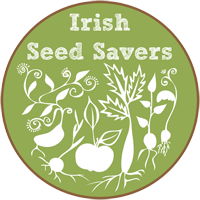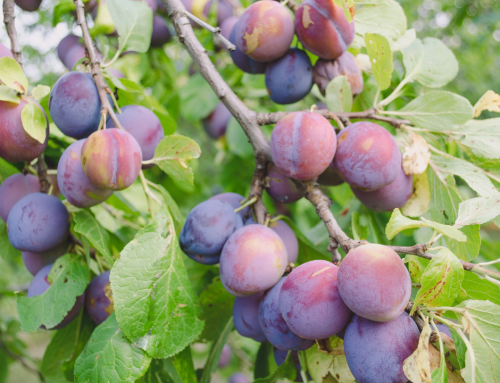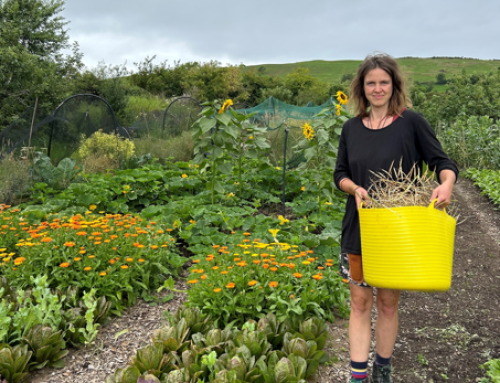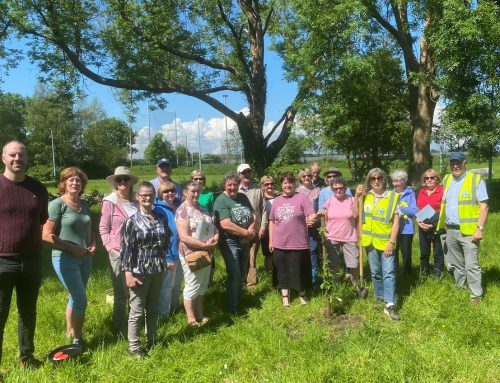Irish Seed Savers Association made a commitment to preserve, conserve and share heritage seed varieties when it began over 30 years ago. This pledge remains as vibrant and strong today as it did then and involves not only the physical aspects of gathering, growing and saving seeds and Irish heritage apple trees but also the important work of preserving the intangible cultural heritage* that they hold too.
Every seed has a story and one of the many joys of my role as Seed Bank Co-Ordinator, is the gathering, documenting and sharing of some of the stories, histories, origins and people behind the many varieties held in our collection. So it was with great excitement that I took a phone call in Spring 2022 from Joe Flannelly, a native of Ballinrobe Co. Mayo, who wished to share some of his story surrounding a cabbage variety grown and saved by generations of his family and that might possibly be one of the varieties held in our seedbank!
From the outset Joe was very eager not to make any false claims, hence his call to find out some more information about the particular variety, which came to Irish Seed Savers via the UK Vegetable Genebank (UKVGB) at Warwick University, Wellesbourne campus. I was delighted that he wanted to share his story and in turn I wanted to share it here to highlight the important rich cultural, social and historical information held in seed by the farmers and growers who have cultivated the land before we did.
Joe started off by telling me that three generations of his family have been growing and saving seed of a cabbage variety in the area of Knocknakillew. He mentioned that he had written down some information about his life and the area where they live for his children and grandchildren and that cabbage was featured in it.
His father and his grandfather before him grew and sold the cabbages (as young plants) to local farmers, to the local market and to a nearby hospital and college who had farms attached and they would also exhibit the cabbages in the local show. He spoke fondly of how, as children, they learned so much about life through the growing of cabbages and their family business; how to deal with people, how to be kind and considerate to people. He recalled that farmers would come up to the house to buy the cabbage plants and his father would designate which one of them would go out and attend to the customer, they would take it in turns, and they would take the customer out to the shed where the cabbages were stored under a large canvas, and they would negotiate the price.
Joe explained that back in those days, cabbage plants would generally be sold to farmers in bundles of 100’s but his father always sold them in batches of 120. This was so that if there were any failures or losses the farmer would still come out with 100 good plants. Looking back, he can see this was a good marketing strategy before anyone knew what a marketing strategy was…it was just what his father did.
As I enquired further, Joe shared with me that they would pull-up the young plants which were sold bare root and bundle them first in 30’s and his mother was brilliant at wrapping them “it was art in itself” he recollected. His father would tie them; he talked about his father always using the Old Moore’s Almanac, and that he was very specific about when to sow the seed for these plants, a lot of attention went into this. He said that his father would say if the seed for these plants were sown around a new moon, they would grow fine but they would bolt (go to seed in the first year), so that was avoided. We now know of course that there are many wonderful growers who follow the principles of Biodynamic gardening, taking into account the calendar of the moon and planetary movements.
He explained that there was a gentleman’s agreement with another farmer in Knocknakillew who grew and bred this particular cabbage not to breed any other type of cabbage for fear of cross pollination, this ensured the purity of the breed. He also noted that they didn’t grow any other brassicas on the farm either to ensure they kept clubroot out. This type of agreement was practiced throughout Ireland and the nearest breed was about 40 miles away from Knocknakillew.
I queried Joe a bit more as my interest continued to grow and he continued that they had a half an acre area of cabbages for their own family’s use and they saved seed from selected mature cabbage heads each year. He went on to explain that as a young child of about 10 years old he was well versed in selection, how to select the best cabbage heads, and they would mark those cabbage to keep for seed and the rest would be for food and fodder. He said the animals were fed outside, there were no indoor slatted feeding sheds at the time. Cabbages were highly nutritious and over the winter were fed to cattle. He said the cabbage itself had a huge white head, was sweet and beautiful to eat and was of the Flat Dutch type. Although this was known as a cow cabbage, it was also valuable as a winter vegetable when other vegetables were scarce.
I asked Joe how the land had been prepared for sowing and how they saved the seed;
He said that there was a ploughman that his father always had in to plough the land first and no other ploughman would do, this ploughman was so good that not a blade of grass would grow up between the furrows. Then the wooden harrow was used to break up the clods. His father would often cut a blackthorn bush in May and they would fasten this onto the harrow so that after sowing it would “set” the seed and then they would roll it with a stone roller (pulled by Dan their donkey).
With regard to sowing, he indicated that his father would get clay and make it fine, like flour and then he’d take 40% cabbage seed and 60% clay and mix the two and then he would broadcast that. They made tracks with their foot about 2 yards wide and his father would sow between the tracks.
With regards to growing for seed and harvesting, Joe said that they would harvest the plants chosen for next years seed in the autumn (Year 1). Root, stem and cabbage head would be tied to the rafters in their old corn shed. Through the winter the heads would naturally decompose and fall off, and, as you can imagine, he said the smell was pretty awful in there at times. In the spring then, they would take the plant from the corn shed (stalk and root) and they would transplant that back out in the field and this would then grow to seed. This was a very good management policy as you had all the heads together and when the stalks went to seed, they would need supporting (with long hazel sticks) and were much easier to manage in a plot close together, this made easier things for the bees too, they didn’t have to travel too far to do their essential work of pollination. I found this intriguing, as our current practice at Irish Seed Savers today is to allow the cabbage to overwinter in the field. This does require quite a lot of de-leafing late winter and its pretty slimy work as it decomposes so perhaps, we could do a trial of the older method in the future.
After harvesting, Joe said they would cut the stems with the pods into a large bag that his mother had made; a big bag, made from sewing flour bags together, and that was then hung from the rafters in the corn shed. Anytime they went in there, they’d give the bag a few taps with an old hurley or stick so the seeds would drop to the bottom of the bag. They would then remove the chaff/pods and blow off any small bits of chaff (using the large tray his mother had for serving tea to the parish priest when he called). The seed was then placed in a biscuit tin (it was very dry at this time Joe said) and it was used the following July for that year’s sowing.
Joe was curious as to how Irish Seed Savers had obtained the “Mayo Common” Cabbage that we have on our website (which also points to Knocknakillew). From a basic search of our database, I was able to say that we had obtained the seed from the Wellesbourne Gene Bank in the UK but I didn’t have much more information than that as gene banks traditionally do not capture the precious social or cultural history of seed. As someone who studied history at college, I find these stories are so important to capture and share. Stories of our collective wisdom, our arts and methods gleaned from centuries of caring for the land and from plain hard work and the passing on of knowledge. Stories of times when a lot of Irish people were self-sufficient and provided food security for others.
I promise to do some more research hopefully we can find out some more information. It would be absolutely wonderful if we were able to find links back to Joe’s family farm and ancestors and this landrace** cabbage variety.
If you or someone close to you have any stories to share with us on heritage Irish vegetables, please do get in touch at info@irishseedsavers.ie
*Intangible cultural heritage can be understood as “living heritage” examples include, oral traditions, songs, knowledge of natural spaces, foods, traditions, cultural practices.
**A Landrace variety is defined as: a local variety of a species of plant or animal that has distinctive characteristics arising from development and adaptation over time to conditions of a localized geographic region and that typically displays greater genetic diversity than types subjected to formal breeding practices – Merriam Webster Dictionary
By Deirdre Morrissey, Seed Bank Coordinator
















